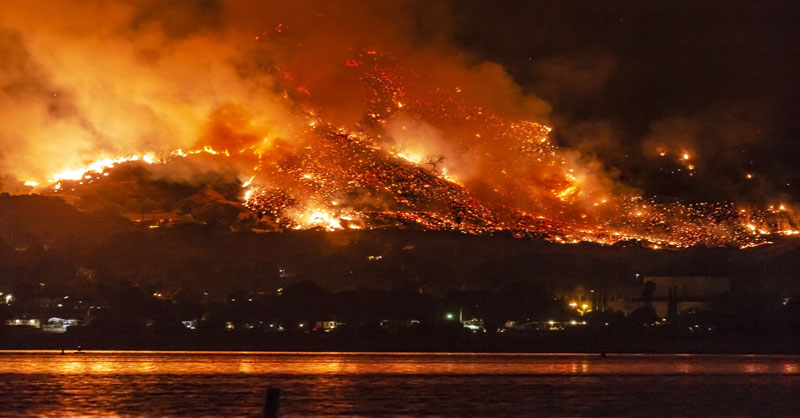In the Moment: Your Emergency Response Plan

Having an emergency response plan so everyone in your organization is aware of what needs to happen in case of a wildfire is critical to help keep your business and employees safe. Implement the plan and practice it often with key stakeholders to help ensure its effectiveness and efficiency. It is also important to remember that situations are constantly changing, and organizations should remain flexible and vigilant.
If a wildfire is quickly approaching your location, stay aware and alert, and be ready to take action. Consider these recommendations from CAL FIRE to help develop your plan so you can respond appropriately when the need to evacuate arises.
Know When to Evacuate
Leave as soon as recommended by local fire officials to avoid being caught in fire, smoke or road congestion. Don’t wait to be ordered by authorities. Evacuating the area immediately upon recommendation also helps firefighters keep roads clear of congestion and lets them move more freely to do their job. In an intense wildfire, they will not have time to knock on every door. If you are advised to leave, don’t hesitate!
- Officials will determine the areas to be evacuated and escape routes to use depending upon the fire’s location, behavior, winds, terrain, etc. Follow their advice.
- Law enforcement agencies are typically responsible for enforcing an evacuation order. Follow their directions promptly.
- You will be advised of potential evacuations as early as possible. You must take the initiative to stay informed and aware. Listen to your radio/TV for announcements from law enforcement and emergency personnel.
- You may be directed to temporary assembly areas to await transfer to a safe location.
Inform Stakeholders and Assess Damage
Once the evacuation has taken place, inform all appropriate stakeholders of the situation. This may include employees, vendors, customers, the public and media. It is important during this time to decide the extent of the continuity of services plan needed. You should attempt to evaluate the extent of damage to the property using resources from state and local governments.
Consider Air Quality Index (AQI)
During wildfires, smoke and air quality cause a concern for those who are in sensitive groups including those with asthma, pregnant women and children. AQI is a measure of particulate matter (PM) which is the primary pollutant in the air resulting from smoke. Any PM lower than 10 micrometers can potentially be inhaled and can even get though certain masks. The PM from wildfire smoke is estimated to be around 2.5 micrometers, which causes concern. Particles of this size are small enough to enter the deepest part of the lungs and potentially the bloodstream, reaching the heart.
AQI is measured using a 0 to 500 scale that determines what kinds of particulates are in the air and how much is in the air.
| 0-50 | Good | Normal Activities |
| 51-100 | Moderate | Extremely sensitive groups should limit exposure |
| 101-150 | Unhealthy for Sensitive Groups | Sensitive groups should limit exposure |
| 151-200 | Unhealthy | Sensitive groups should avoid exposure |
| 201-300 | Very Unhealthy | Everyone should consider refraining from outdoor events |
| 301-500 | Hazardous | Everyone should consider refraining from outdoor events |
Resources
- California Air Resources Board | Protecting Yourself from Wildfire Smoke
- CAL Fire | Take Action Immediately When Wildfire Strikes
- Insurance Information Institute | Facts + Statistics: Wildfires









